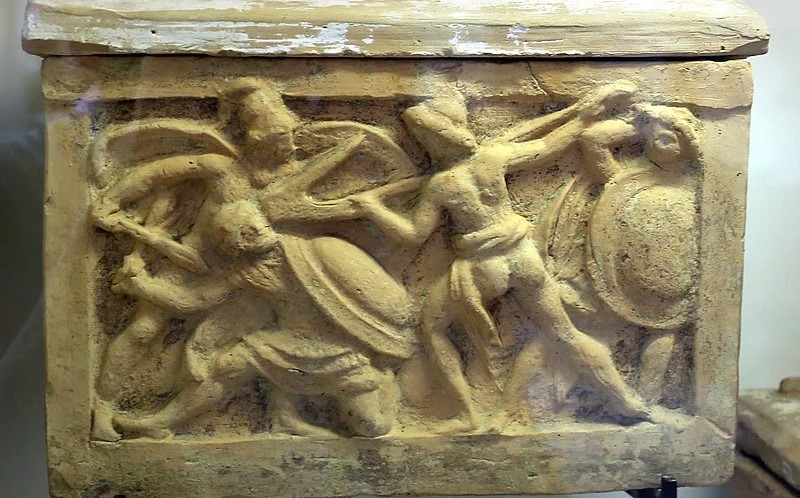
Echetlaeus, or Echetlus, was the name of a mysterious ancient Greek ‘phantom’ warrior who appeared in the Battle of Marathon and helped to stop the Persians from invading Greece. He then suddenly disappeared.
The battle hero seems to have come out of nowhere. He appeared in the midst of the battle against the Persians. While he was not in soldier’s armor and wore a farmer’s hat, he is commonly displayed with a weapon that looked very much like a plow.
The mysterious appearance of the man in the middle of the battle is referenced by two ancient Greek historians, Pausanias and Herodotus. However, their descriptions differ and contain imagery that could be described as supernatural.
The name Echetlus derives from the ancient Greek word “echetle” (Greek: εχέτλη) in reference to the handle of the plow. His name probably originates from the plow handle that he is said to have carried while fighting the Persians, and because no one knew or saw him after that, they named him after it.
In Italy, an ancient Etruscan sarcophagus is adorned with a sculpture depicting the Battle of Marathon and containing a particular figure resembling a farmer. This figure is in possession of a plow he is using as a weapon, and he is in the midst of a fight.
A half-naked man fights three warriors with a plough – a common scene on #Etruscan ash chests.
Is he the Greek hero Echetlus, who aided the Athenians at the Battle of Marathon in 490 BC, before mysteriously disappearing? Why would an obscure Greek legend be popular in #Etruria? pic.twitter.com/TOJszC7UVv
— Kulturhist. museum (@Kulturhistorisk) June 22, 2023
Moreover, in Stoa Poikile in Athens, located in the Ancient Agora of Athens adjacent to the Acropolis, a fifth century BC painting depicts the elusive ancient Greek warrior along with Heracles and the goddess Athena. This is an indication of how much Athenians valued and honored their heroes.
But the question is—what was he?
Pausanias and Herodotus describe the ancient Greek phantom warrior, Echetlus
The description of the disappearance of the unknown fighter after the Battle of Marathon by Pausanias is as follows:
“They also say that a man with archaic appearance and clothes happened to be present in the battle. After killing many of the foreigners with the hetli, he disappeared when the battle was over. When the Athenians asked the oracle, the god simply instructed them to honor Echetlaeus as a hero. They even erected a white marble monument…the Athenians affirm that they buried the Persians, because in every case divine law ultimately states that the dead body should be buried under the earth, yet they did not find a grave. There was no tumulus or other mound of earth visible, as the dead were thrown into a ditch.”
Herodotus gives a different description of the puzzling presence of the ancient Greek phantom warrior:
“…in the battle of Marathon 6,400 Persians and 192 Athenians were killed. During the conflict something very strange happened: an Athenian soldier, Epizilus, son of Koufagoras, while fighting bravely suddenly lost his vision in both eyes, although nothing had touched him, neither spear nor sword nor bow and arrow.”
Continuing, Herodotus states that “Epizilus tells of seeing a gigantic hoplite whose beard covered his entire shield, and that this specter (or ghost, from the Greek word :Φάσμα) overtook him, and killed the Persian opponent that was standing next to him. This scene was the last Epizilus saw. The Athenians asked the Oracle of Delphi to find out who the unknown hero who fought with them was but the Oracle only gave them the answer that they should honor the hero Echetlaeus.”
Was Echetlus a being of another dimension or even a time traveler?
In ancient Greek history, the presence of Echetlus at the Battle of Marathon and his disappearance afterwards was never explained. There are some theories that he was sent by the god Pan, who was said to be watching the battle from his cave. Others have said he was sent by goddess Demeter and Persephone.
In modern times, there are some speculations that are quite incredible. Indeed, there are depictions of a farmer-like figure fighting the Persians with a plow in Marathon. But what became of him afterwards?
According to a modern theory, the weapon Echetlus used was a sophisticated raygun, hence the bright light that blinded Epizelus. Another theory has it that Echetlus was a time traveler or a being from another dimension who joined the battle to help.
According to Swiss historian F. Pfister, this was a time when ancient Greece was in a transitional period. The Greeks were going from Homeric hero worship to the new gods of the Classical period. In a painting by Pansinus, who was the brother of Pheidias, Echetlus was depicted among the heroes of the Battle of Marathon. That painting is displayed in the Stoa Poikile.
See all the latest news from Greece and the world at Greekreporter.com. Contact our newsroom to report an update or send your story, photos and videos. Follow GR on Google News and subscribe here to our daily email!



